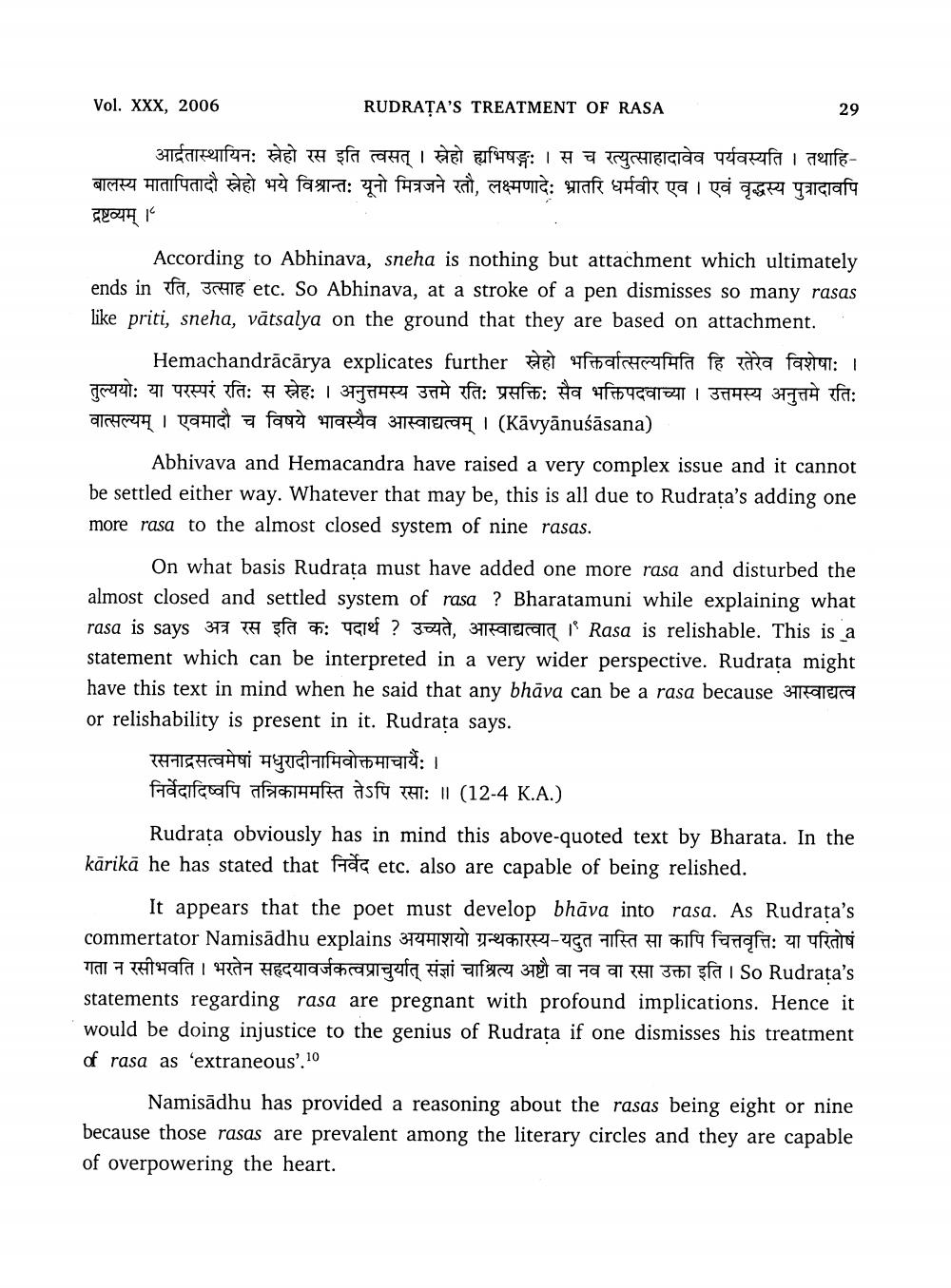________________
Vol. xxx, 2006
RUDRATA'S TREATMENT OF RASA
29
आर्द्रतास्थायिनः स्नेहो रस इति त्वसत् । स्नेहो ह्यभिषङ्गः । स च रत्युत्साहादावेव पर्यवस्यति । तथाहिबालस्य मातापितादौ स्नेहो भये विश्रान्तः यूनो मित्रजने रतौ, लक्ष्मणादेः भ्रातरि धर्मवीर एव । एवं वृद्धस्य पुत्रादावपि द्रष्टव्यम् ।
According to Abhinava, sneha is nothing but attachment which ultimately ends in रति, उत्साह etc. So Abhinava, at a stroke of a pen dismisses so many rasas like priti, sneha, vātsalya on the ground that they are based on attachment.
__Hemachandrācārya explicates further स्नेहो भक्तिर्वात्सल्यमिति हि रतेरेव विशेषाः । तुल्ययोः या परस्परं रतिः स स्नेहः । अनुत्तमस्य उत्तमे रतिः प्रसक्तिः सैव भक्तिपदवाच्या । उत्तमस्य अनुत्तमे रतिः वात्सल्यम् । एवमादौ च विषये भावस्यैव आस्वाद्यत्वम् । (Kavyānusāsana)
Abhivava and Hemacandra have raised a very complex issue and it cannot be settled either way. Whatever that may be, this is all due to Rudrata's adding one more rasa to the almost closed system of nine rasas.
On what basis Rudrata must have added one more rasa and disturbed the almost closed and settled system of rasa ? Bharatamuni while explaining what rasa is says अत्र रस इति कः पदार्थ ? उच्यते, आस्वाद्यत्वात् ।' Rasa is relishable. This is a statement which can be interpreted in a very wider perspective. Rudrata might have this text in mind when he said that any bhāva can be a rasa because 3CE or relishability is present in it. Rudrata says.
रसनाद्रसत्वमेषां मधुरादीनामिवोक्तमाचार्यैः । निर्वेदादिष्वपि तन्निकाममस्ति तेऽपि रसाः ॥ (12-4 K.A.)
Rudrata obviously has in mind this above-quoted text by Bharata. In the kärikä he has stated that fid etc. also are capable of being relished.
It appears that the poet must develop bhāva into rasa. As Rudrata's commertator Namisadhu explains अयमाशयो ग्रन्थकारस्य-यदुत नास्ति सा कापि चित्तवृत्तिः या परितोष गता न रसीभवति । भरतेन सहृदयावर्जकत्वप्राचुर्यात् संज्ञां चाश्रित्य अष्टौ वा नव वा रसा उक्ता इति । So Rudrata's statements regarding rasa are pregnant with profound implications. Hence it would be doing injustice to the genius of Rudrata if one dismisses his treatment of rasa as 'extraneous'.10
Namisādhu has provided a reasoning about the rasas being eight or nine because those rasas are prevalent among the literary circles and they are capable of overpowering the heart.




